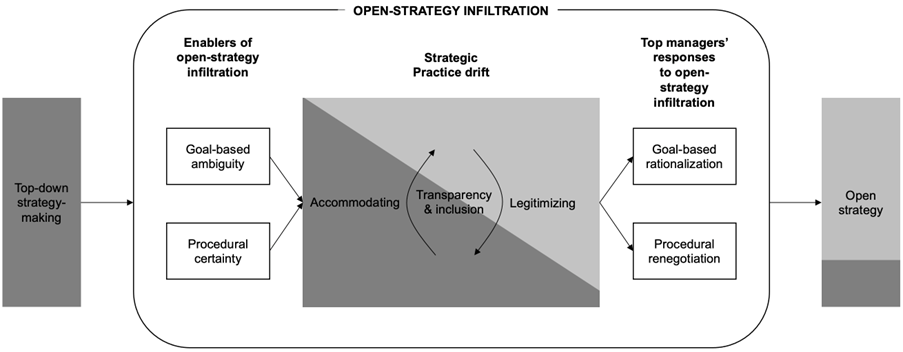
Opening up the strategy process, despite top management intentions. Conventional strategy processes tend to be opaque and elitist in nature, being performed mostly by top management. Yet, emerging research points to benefits of increased transparency and inclusion in the strategy process, called ‘Open Strategy’. Open strategy offers benefits such as increased quality, commitment, and legitimacy of formulated and implemented strategies. Yet, it threatens established power relations in that it is partly at odds with top managers’ interests, who may resist or work against the incorporation of open strategy in the strategy process. Therefore we ask, how can open strategy enter an organization not because of top management intentions but despite them?
In our paper, published in the Journal of Management Studies, we elaborate the notion of open-strategy infiltration, i.e., the incorporation of open strategy into strategy processes behind the backs of top managers. Our ethnographic study tracked an 18-month process of open-strategy infiltration in FFR, a traditional, hierarchical organization in the financial services sector. The process started when managers agreed to implement a project management method known as ‘Agile’, without being fully aware that this initiative latently implied the use of practices that led to increased transparency and inclusion in the strategy process. As Agile was implemented and practised, the firm’s strategic practices gradually shifted from top-down strategy-making as being the exclusive realm of top management to widespread practices creating and reinforcing transparency and inclusion in the strategy process. The firm’s top managers became aware of these profound dynamics much later, when practices of transparency and inclusion had already become part of the strategy process. Consequently, it was difficult, if not impossible to revoke these shifts.
Embedding transparency and inclusion in the strategy process. Based on the empirical observations, we suggest a process model describing enablers, processes and top manager’s reactions displayed in Figure 1.

First, ‘goal-based ambiguity’ of the new strategy coupled with the ‘procedural certainty’ offered by the Agile initiative paved the way for open-strategy infiltration. Not unlike many organizations, FFR’s top managers assigned several and partially conflicting goals to the strategy, including the simultaneous pursuit of greater customer service, flexibility, and efficiency. Due to goal-based ambiguity, it was not clear how to transform the strategy into meaningful initiatives. Yet, top management team believed that the implementation of the strategy would require a well-functioning IT and digitalization department. Coincidentally, that department was undergoing an Agile transformation, and proposed to top management to ‘scale’ Agile practices across the firm. Agile and scaled agile methods count with well-established processes, practices and ceremonies, offering top management team a clear path ahead, which we called ‘procedural certainty’. Goal-based ambiguity in tandem with procedural certainty allowed managers and employees to project various hopes and expectations onto the adoption of the method, while having a consensus around the process moving forward.
Then, we show how open strategy infiltrates the strategy process through a ‘strategic practice drift’, i.e., a gradual and partly unnoticed shift towards open strategy that occurs through ‘accommodating’ and ‘legitimizing’ the performance of transparency and inclusion in the strategy process. Accommodating refers to the first phases of experimentation with and implementation of Agile in pockets of the organization. We noted how the very practices of Agile such as its bottom-up prioritization and involvement of several stakeholders contributes to higher levels of transparency and inclusion. At the same time, the team responsible for implementation of Agile kept records showcasing the success of agile in terms of increased effectiveness and satisfaction in the implementation of strategic issues. Such records were presented to organizational actors, including senior managers, and lent higher levels of legitimacy to the initiative. Accordingly, the senior managers agreed to spread Agile across the organization, beyond its initial ‘pockets’.
Finally, we show how top managers eventually respond to the strategic practice drift through the ‘goal-based rationalization’ and ‘procedural renegotiation’ of practising transparency and inclusion in the strategy process and, in doing so, contribute to the eventual reproduction of open strategy in the strategy process.
Reflecting on the side effects of scaled Agile. The main contribution of our study is to develop a model that conceptualizes the process of open-strategy infiltration. This model generates an understanding of how and why open strategy can enter the strategy process behind the backs of top managers, who tend to lack an interest in eroding the opaque and exclusive strategic practices in which they play dominant roles.
In conclusion, our paper shows an alternative approach for opening up strategy processes that is not dependent on top managers and embeds transparency and inclusion into the day-to-day ‘doing’ of strategy work. Our study also conveys a note of opportunity and caution. Our study centres on the managers adoption of Agile as another megatrend in the business world, and shows that it not only changes the nature of how work is performed, but also invokes strategic practice drifts towards the performance of transparency and inclusion in the strategy process. These observations are interesting, as they dismantle the seemingly innocent nature of Agile as a ‘project management methodology’. These broader ramifications raise managers’ and employees’ awareness of the potential side effects that should be factored in when adopting Agile. The same may hold true for other ever-more popular methods, such as design thinking and foresight, which are equally not fully explicit about the greater need for transparency and inclusion as well as the broader implications for organizations’ strategy processes.

0 Comments